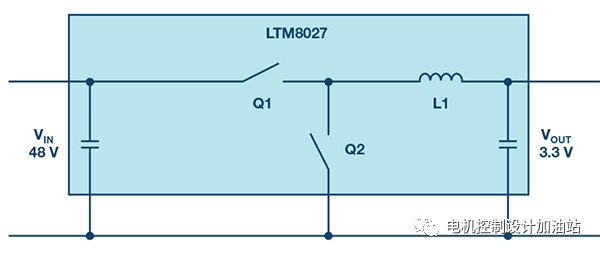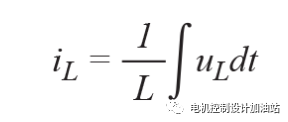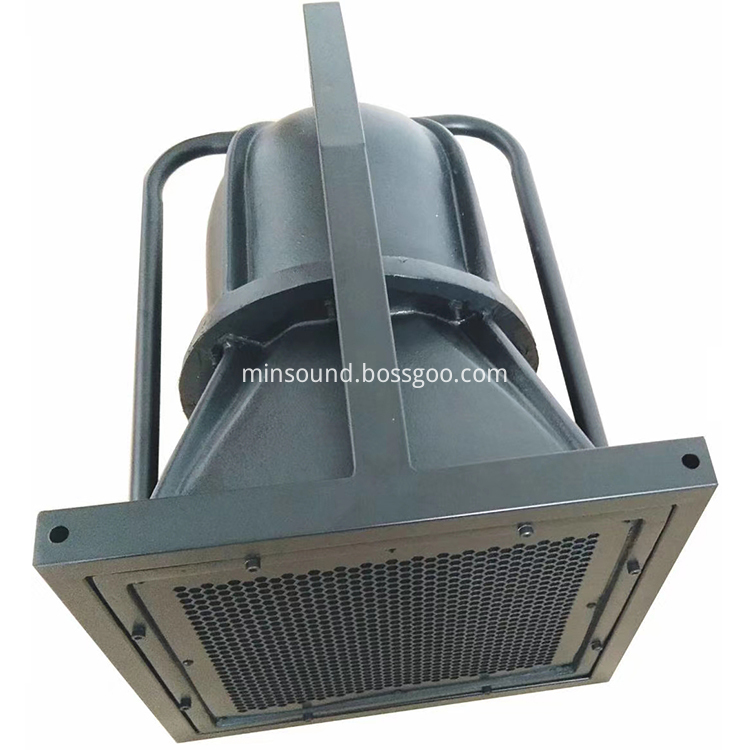For applications that need to switch from a high input voltage to a very low output voltage, there are different solutions. An interesting example is the conversion from 48 V to 3.3 V. Such specifications are common not only in server applications in the information technology market, but also in telecommunications applications.

Figure 1. The voltage is reduced from 48 V to 3.3 V in a single conversion step.
If a buck converter (buck converter) is used for this single conversion step, as shown in Figure 1, the problem of small duty cycle will occur. The duty cycle reflects the relationship between on time (when the main switch is on) and off time (when the main switch is off). The duty cycle of the buck converter is defined by the following formula:

When the input voltage is 48 V and the output voltage is 3.3 V, the duty cycle is approximately 7%.
This means that at a switching frequency of 1 MHz (1000 ns per switching period), the on-time of the Q1 switch is only 70 ns. Then, the Q1 switch is turned off for 930 ns, and Q2 is turned on. For such a circuit, a switching regulator must be selected that allows a minimum on-time of 70 ns or less. If you choose such a device, there will be another challenge. Generally, when operating with a very small duty cycle, the high power conversion efficiency of the buck regulator decreases. This is because the time available to store energy in the inductor is very short. The inductor needs to be powered during a long off time. This usually results in very high peak currents in the circuit. In order to reduce these currents, the inductance of L1 needs to be relatively large. This is because during the on-time, a large voltage difference will be applied across L1 in Figure 1.
In this example, the voltage across the inductor during the on-time is about 44.7 V, the voltage on the switch node side is 48 V, and the output voltage is 3.3 V. The inductor current is calculated by the following formula:

If there is a high voltage across the inductor, the current in the fixed inductor will rise for a fixed time. In order to reduce the inductor peak current, a higher inductance value needs to be selected. However, higher inductance values ​​increase power loss. Under these voltage conditions, Analog Devices’ high-efficiency LTM8027 µModule® regulator achieves only 80% power efficiency at 4 A output current.

Figure 2. The voltage is reduced from 48 V to 3.3 V in two steps, including a 12 V intermediate voltage.
Currently, a very common and more efficient circuit solution to improve power efficiency is to generate an intermediate voltage. Figure 2 shows a cascade setup that uses two high-efficiency step-down regulators. The first step is to convert the 48 V voltage to 12 V, and then convert the voltage to 3.3 V in the second conversion step. When falling from 48 V to 12 V, the total conversion efficiency of the LTM8027 μModule regulator exceeds 92%. The second conversion step uses LTM4624 to reduce 12 V to 3.3 V, and the conversion efficiency is 90%. The total power conversion efficiency of this scheme is 83%, which is 3% higher than the direct conversion efficiency in Figure 1.
This may be quite surprising, because all the power on the 3.3 V output needs to pass through two separate switching regulator circuits. The efficiency of the circuit shown in Figure 1 is lower due to the short duty cycle, which results in higher peak inductor current.
When comparing the single-step buck architecture with the intermediate bus architecture, there are many other aspects to consider in addition to power efficiency. However, this article only intends to discuss the important aspects of power source conversion efficiency. Another solution to this basic problem is to use the new hybrid step-down controller LTC7821. It combines charge pump action with step-down regulation. This makes the duty cycle up to 2 × VIN/VOUT, so a very high step-down ratio can be achieved at a very high power conversion efficiency.
The generation of intermediate voltage may be quite useful for improving the overall conversion efficiency of a particular power supply. In order to improve the conversion efficiency under the extremely small duty cycle in Figure 1, a lot of development work has been carried out in the industry. For example, very fast GaN switches can be used to reduce switching losses, thereby improving power conversion efficiency. However, the cost of this solution is currently higher than the cascade solution (for example, as shown in Figure 2).
Long Range Fiberglass Horn Speaker
Long-range glass fiber reinforced plastic Horn Speaker, the box is made of glass fiber and anti-aging agent, durable, beautiful and environmentally friendly, built-in network decoding module, stereo power amplifier, high-fidelity speaker
Remote FRP horn-type integrated network audio decoding speaker, used for audio decoding and sound restoration in broadcast partitions, especially suitable for open-air environments, such as sports venues, parks, exhibitions, etc.

Long Range Fiberglass Horn Speakers,waterproof glass fiber horn speaker,Stadium Horn Speaker,full range horn speaker, Fiberglass Horn Speaker
Taixing Minsheng Electronic Co.,Ltd. , https://www.ms-speakers.com
